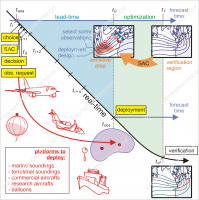Accueil > Our research topics > Adaptive Observation > A few concepts about adaptive observation
Definition :
Adaptive observation is a specific practice when collecting atmospheric data for assimilation into numerical weather prediction (NWP ) systems. This practice is designed to change a part of the observing system depending on the expected weather conditions. The goal of this local (time and space-wise) change is to make the system of assimilation/prediction more effective and to improve the quality of forecasts. Adaptive observation is also called observation targeting.
Routine or adapted observations :
Here, we distinguish between adapted observations and the routine observations. The adapted observations are those to be (or not) deployed as part of a targeting procedure. The rest are routine observations. Only meta-data distinguish routine and adapted observations.
The types of adaptive platforms :
Various types of platforms observation can be used.
The most "dedicated" platforms are research aircraft that sample the atmosphere below their trajectories with radio-soundings or lidars.
However, you can also use radio-sondes (land or equipped merchant ships) that are operated outside of their normal schedule (routine). The increased transmission of observations of commercial aircraft is another way. Finally, we can also increase the frequency of satellite observations.
The (targeting) procedure :
The adaptive observation following the procedure in real time following, illustrated by the following diagram :
At the initial and present moment, one studies the weather forecasts issues from the analysis of the day (tana on the diagram) in an interval of ranges that is consistent with the deployment of additional observations (typically 2 to 5 days range). In these predictions, one detects a weather event of interest (e.g. high uncertainty, high societal or economic potential, or more extreme nature of these features that make the whole procedure worthwhile). This weather event is determined by a range, a validity date and a geographic area. This is the verification (marked tvf on the figure).
Between tvf and tana, on choose the moment t_obs which determines when the potential additional observations would be deployed.
These 3 dates (or moments) define two intervals : the lead-time and the optimization-time. The choice of the moment tobs
can be either arbitrary, fixed by physical constraints or based on indications about the evolution of uncertainty in this period.
The 3 dates (tana, tobs, tvf) and the verification box define an adaptive observation "case".
Then, a numerical tool (called targeting technique) is used to determine where and how to deploy additional observations, based on pre-established scenarios of deployments. See the following article about the numerical tools. At this stage, one decides whether to proceed or not and to deploy additional observations. In such a case, it should transmit the observation order to the various partners and observation suppliers (National Meteorological Center, supra-national weather authorities, airlines operating centers, satellite exploitation centers and research services).
After the prescribed lead-time, the additional observations are collected in the same way than the routine observations and operational data assimilation and prediction systems do not make any difference between adaptive and routine observations. It is necessary to carry an OSE (an a posteriori impact impact study, after tvf) to verify that the effectively deployed additional observations (at tobs) have had the expected benefit on the forecasts.
The adaptive observation campaigns :
The procedure of adaptive observation is generally implemented in the context of specific field campaigns.
Indeed, it requires a strong interaction between the NWP actors, but with a reverted information flow with respect to the usual one. Moerover it requires a strong cohesion at a supra-national level that implies the existance of an authority at this level. Over time, the adaptive observation campaigns are directed towards simpler and lighter devices, with increasing automation of routine platforms used in flexible mode (see section application to field experiments).





